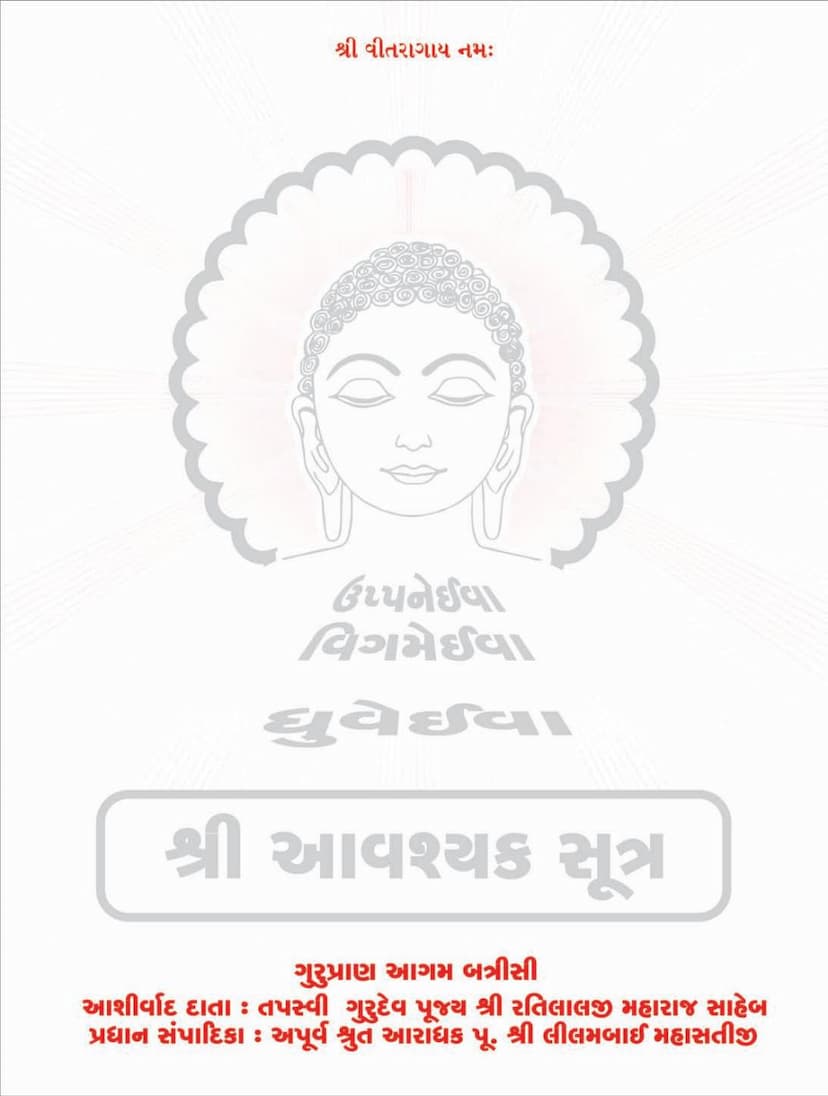Agam 28 Mool 01 Avashyak Sutra Sthanakvasi
Added to library: September 1, 2025

Summary
This Jain text, Agam 28 Mool 01 Avashyak Sutra Sthanakvasi, published by Guru Pran Prakashan, Mumbai, is a significant work within Jainism, focusing on the foundational Avashyak Sutra. The title itself, "Agam 2 8 Mool 01," indicates it's the first fundamental text (Mool 01) within the 28 Agams, specifically dealing with the Avashyak Sutra, and it is presented in the tradition of the Sthanakvasi sect.
The book is dedicated to revered Gurudevs of the Gondal Gachchha, including the lineage leading up to Pujya Shri Dungarsinhji M.S., Pujya Shri Pranalalji M.S.A., and Tapsamrat Gurudev Pujya Shri Ratilalji M.S.A. The compilation and publication are presented as a tribute and commemoration, particularly coinciding with the birth centenary of Gurudev Shri Pranalalji M.S.A.
Key aspects and content of the text, as gleaned from the provided pages, include:
- Nature of the Text: It's a re-publication of the Avashyak Sutra, presented with its original text (Moolpath), its meaning (Bhavarth), commentary (Vivechan), and supplementary materials (Parishisht). The re-publication is a significant effort, with multiple editions and printing runs mentioned, indicating its importance and demand within the community.
- Authorship and Guidance: The work is attributed to the blessings and guidance of several Mahasatijis, including Rupabai Mahasati, Artibai Mahasati, and Subodhikabai Mahasati. Pujya Shri Lilambai Mahasatiji is credited as the chief editor. The publication is also graced by the inspiration and blessings of prominent munis like Pujya Shri Jayantmuni M.S.A., Pujya Shri Girishmuni M.S.A., and Pujya Shri Janakmuni M.S.A., among others.
- Content Focus (Avashyak Sutra): The core of the text is the Avashyak Sutra, which details the essential duties or practices (Avashyak) of a Jain monk or nun. From the content and table of contents, we can infer it covers:
- Six Essential Duties: The text explicitly mentions the six essential duties of Jain ascetics: Samayik (equanimity), Chaturvimsatistav (praise of 24 Tirthankaras), Vandana (obeisance), Pratikraman (repentance/confession), Kayotsarg (abandonment of body), and Pratyakhyan (renunciation/fasting).
- Detailed Commentary and Explanation: The text provides detailed explanations (Bhavarth, Vivechan) for each of these duties, their significance, and the underlying principles.
- Importance of Vows and Practices: The text emphasizes the importance of adhering to these practices for spiritual progress, purification of the soul, and ultimately, liberation (Moksha).
- Mool Sutra and Gujarati Translation: It includes the original Sutra text (Moolpath) and its Gujarati translation and commentary, making it accessible to a wider audience.
- Historical Context and Lineage: The text includes biographies and tributes to revered Gurudevs and Mahasatijis, highlighting the lineage and philosophical tradition (Gondal Gachchha) to which the publication belongs. It also provides historical context about the re-publication efforts.
- Specific Sutras Covered: The table of contents (Vishayanukramanika) reveals the detailed structure, covering specific sutras like Samayik Sutra, Pratikraman, and various procedural aspects related to these essential practices. It also includes appendices like "Samayik Ek Parishilan," "Pratikraman Ek Parishilan," and "Shravak nu Pratikraman."
- Key Themes and Concepts:
- Righteousness and Equanimity: The emphasis on Samayik as the first essential duty and its connection to Samata (equanimity) is prominent.
- Repentance and Purification: The Pratikraman section, particularly its detailed explanation of the "Pratikraman Sutra," highlights the process of confessing and rectifying past errors (dosh) through introspection, repentance, and seeking forgiveness, underscoring the importance of spiritual purification.
- Discipline and Austerity: The text covers various forms of self-discipline and austerity, such as the six essential duties, which are crucial for ascetics.
- Devotion and Respect: The reverence for Gurudevs and the detailed inclusion of their life sketches and blessings show a deep sense of devotion and respect for the spiritual lineage.
- Ethical Conduct: The mention of various admonitions and prohibitions, like avoiding certain actions during specific times (Astavasthyakal mentioned in page 14 and Parishisht 1, concerning the 32 types of 'Avasthyakaal' or prohibited times for study), indicates a strong emphasis on ethical conduct and disciplined living.
- Thematic Focus on Samayik and Pratikraman: The "Abhigam" section, written by Pujya Shri Jayantmuni M.S.A., delves deeply into the meaning and philosophy of "Pratikraman," reinterpreting its literal meaning beyond just "turning back" to an active "going towards purification and higher consciousness." The "Sampadakiy" section by Pujya Lilambai M.S.A. further elaborates on the spiritual significance of the Avashyak Sutra, particularly Samayik, as a path to self-discovery and liberation.
- Inclusion of Shravak Vratas: The appendix (Parishisht) sections provide detailed explanations of the Shravak Vratas (lay vows), including the five Anuvratas, three Gunavratas, and four Shikshavratas, along with their respective aticharas (transgressions). This shows the text also caters to the understanding and practice of lay followers.
- Linguistic and Explanatory Approach: The text utilizes Gujarati for the translation, explanation, and commentary, making the complex philosophical and practical aspects of Jainism accessible. The detailed explanations and adherence to the original script (Moolpath) are stressed.
In essence, this book is a comprehensive guide to the Avashyak Sutra for the Sthanakvasi Jain community, offering not only the literal teachings but also the spiritual interpretation, historical context, and devotional tributes to revered spiritual leaders. It serves as a vital resource for understanding and practicing the fundamental tenets of Jain asceticism.